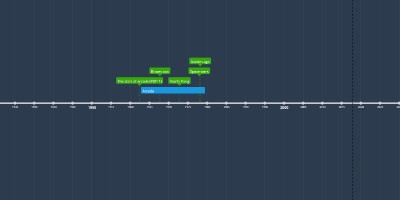Third Gen (2 déc. 1984 – 1 déc. 1992)
Description:
Also known as the 8-bit era, the third generation of video games began with the release of the Nintendo Famicom, known to the English-speaking world as the Nintendo Entertainment System, or "NES". It is considered to be the first of the "modern" era video game generations.As most consoles used 8-bit processors around this time, this generation became known as the 8-bit era, a trend which continued for quite some time as processor strength increased.
It was in this generation that the console wars between Nintendo and Sega began. The NES and SG-1000 released on the same day in Japan, in 1983. While the SG-1000 was moderately successful, the NES became far more successful worldwide. In response to the NES system, Sega released its Sega Mark III, later revamped and released in the English-speaking world as the Sega Master System. Nintendo and Sega both released a hand-held video game console during this generation: the Game Boy and Game Gear, respectively.
Nintendo started this generation in the west with the release of the Nintendo Entertainment System. Lots of precautions were taken due to the North American video game crash - firstly, Nintendo assessed each game for quality, giving their seal of approval to anything that passed. Though ratings bodies were not yet established, Nintendo created a set of rules which all developers wishing to develop games for their system must follow. Anything that was deemed inappropriate for minors would not make the grade, so large amounts of censorship was put in place, such as the removal or recoloring of blood, no adult-orientated themes and even some slightly controversial ones regarding religious references. All early Nintendo games featured box-art that was similar to the graphics seen within games, to assure customers that what they saw was what they got. In Japan these rules did not apply, because the video game crash did not effect that region.
Envy of Nintendo's success, Sega released their Sega Master System across the world. It used an 8/16-bit Z80 CPU combined with an 8/16-bit VDP graphics processor, making it more powerful than the NES (8-bit CPU, 8-bit PPU graphics chip). It achieved the largest market share in places where Nintendo had found little success, particularly PAL regions where Nintendo was not very successful. In Europe, this was the generation where more people moved away from computers and into consoles. Though second generation consoles had existed in this region, they were not overly popular. Nintendo's dominance in other regions still put a strain on Europe however - many video game companies such as Capcom and Konami were barred from developing games for other systems if they wanted to have continued success on the NES. This would change at a later date, but Nintendo did not want to take any chances at this stage.
The third generation also saw the release of the Atari 7800 which was a true successor to the Atari 2600, but it was seen as too little, too late as the system was underpowered in comparison to Nintendo's work and Atari had already lost confidence after the video game crash. It is said that they never really recovered from this, and still struggle somewhat today.
The third generation is notable as it was the first generation where video games started looking like real-life things rather than blocky low-resolution graphics. Suddenly it was starting to be seen as an alternative form of entertainment that could effectively rival television and films.
Ajouté au bande de temps:
Date:
2 déc. 1984
1 déc. 1992
~ 8 years
